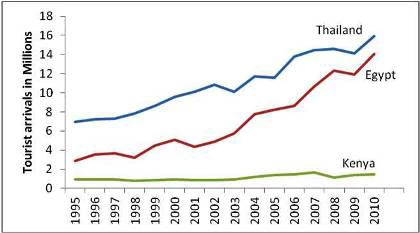
In 1994, I returned with my wife, and in downtown Nairobi, urban chaos and poverty struck her so much, that she was reluctant to come back 15 years later, when I was offered a job.
Today, I enjoy the full beauty of Kenya with my family, and we all agree—my wife included!—that this is one of the most beautiful countries in the world. If you created an index of "natural beauty per square-kilometer" Kenya would probably come up on top of the list. Starting from Nairobi, within a few hours of driving, you enjoy the most amazing nature: the Masai Mara, Mt Kilimanjaro, Mt Kenya, and Lake Victoria, are all within reach. Nairobi is surprisingly pleasant, with one of the best climates in the world: it is one of the few cities where you neither need air-conditioning nor heating—all year long (well, it will soon get “cold” in July but the fireplace will help).
But Kenya’s beauty is not matched by its position in the world of tourism. This should really be one of the top tourist destinations in the World. Instead, Kenya is losing ground to many of its peers. As in many other fields (not least football), Kenya keeps punching below its weight. Over the last 15 years, Kenya’s tourism appears to have stagnated cozily in its comfort zone, while other countries have been taking off. In 2007, Kenya attracted some 1.5 million tourists, but arrivals dropped sharply in 2008, following the post-election violence, and it took three years for the country to recover. By contrast, Thailand and Egypt are attracting respectively 16 and 14 million visitors. Despite floods and political upheavals, these numbers have been growing steadily. Even Singapore, a city with no mountains or animals (outside of Singapore zoo) attracts more than 9 million visitors each year. Munich, which is my home-town, attracts almost 7 million visitors during the two weeks of the Beer Festival. If we can attract millions of tourists with beer and party alone, Kenya should easily meet this target.
Figure - How Egypt and Thailand have been outperforming Kenya
Source: World Bank calculations based on World Travel and Tourism Council
Arrivals are not the only meaningful metric. Some visitors come for short trips, others stay longer; some spend a large amount of money, others stick to a tight budget. But the raw numbers still matter, because each of Kenya’s 1.5 million visitors go back home with stories to tell, which are ultimately shaping the “Brand Kenya”.
Tourism is critical for Kenya’s economy. Together with tea and horticulture, it earns the lion’s share of the foreign exchange. Without tourism, Kenya’s current account deficit would widen further and exceed 15 percent of GDP. And when these visitors exchange their dollars, yens or euros for shillings, the national currency gets a boost. More importantly, tourism is a labor-intensive activity: think of all the jobs created (about 100,000 by some estimates), for park rangers, to airline crews, and hotel employees, who directly rely on it.
But Kenya has much more potential than it currently exploits. This country has an amazing portfolio of attractions to offer: safaris, beaches, and mountains; and something to offer for each “price segment” of the market, from backpackers to business travelers. Airline connections are also good and getting better. Kenya is also benefitting from the economic good fortunes of Asia and Africa. A growing middle-class in emerging economies is increasingly travelling around the world, and ready to enjoy Kenya‘s many attractions. The recent arrival of Korean tourists on direct flights from Seoul is a reminder that there is massive untapped potential in the country.
So what could Kenya do to “polish its diamonds” and unleash its full potential in tourism? Some factors are clearly beyond the government’s control, such as the Euro crisis and, to a large extent, the developments in Somalia. But much can be done.
First, Kenya needs to offer the right package for safaris, beaches, mountains, as well as MICE (meetings, incentives, conventions, exhibitions). Some countries have made the mistake of putting all their eggs into the same basket, for instance by shooting exclusively at the high-end of the market. Having started as a backpacker myself, I am not convinced that Kenya should only court the so called “premium tourists”. Research actually shows that backpackers spend a much larger share of their money on the local economy. If they have a good experience, they will tell their (wealthier) friends and families and, as I did, they may probably come back again.
Second, there is still a long way to go before Kenya’s facilities can reach the same standards as Egypt and Thailand (despite the remarkable high-end camps that are already on offer). Land policies appear to be a particular challenge. Walking along Diani beach, you see so many run-down buildings, inhabited not by wealthy visitors, but by rats and birds. This puts a lot of people off, and also discourages investment, as hotels are being replaced by high rise flats. Better governance helps. The recent introduction of e-ticketing at Masai Mara generates much higher revenues which could be rechanneled into upgrading the infrastructure.
Third, transport remains a challenge even though it has been improving. Nairobi’s international airport is one of the best in the continent, but it is still a long way from being world class. True, you can fly easily to most destinations, but going by road is still a nightmare. My family and I have on many occasions travelled to the Masai Mara, which is truly one of the world’s greatest wonders. But as I load the car before we leave Nairobi, I always think to myself, “How strange. In order to get to paradise, you first have to travel through one of the worst roads in the country!”
*Many thanks to Hannah Messerli for valuable advice.



Join the Conversation